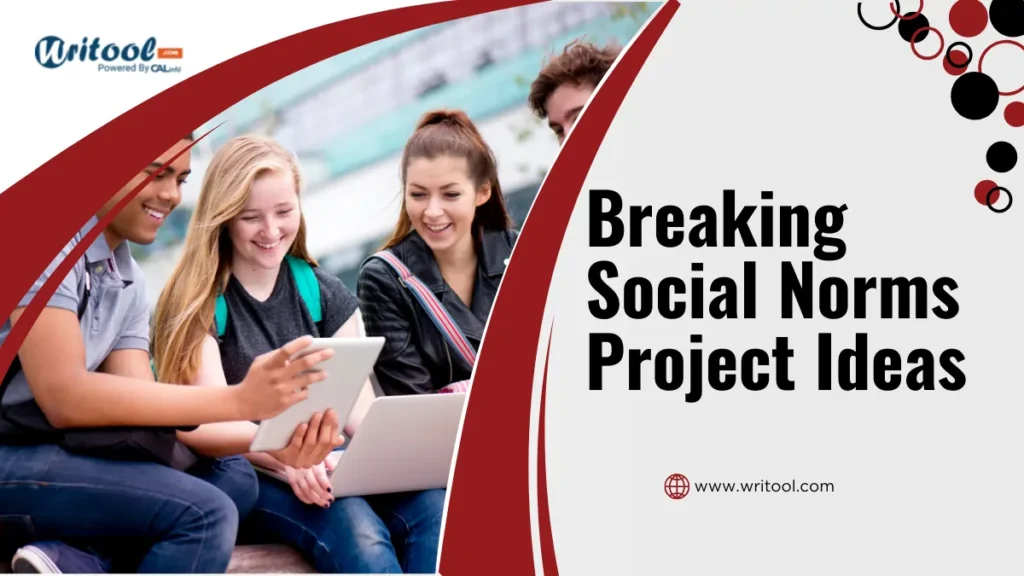Discover engaging Breaking Social Norms Project Ideas For Students to challenge conventions, creativity, and personal growth through social experiments.
Social norms are like invisible rules that guide how we behave in society, from how we dress to how we talk and eat. While they keep things orderly, they can also limit our creativity and self-expression.
Trying out projects that break social norms can be eye-opening and exciting for students. It’s a chance to step out of your comfort zone, question the usual ways of doing things, and see how people react.
This blog will explore cool project ideas that challenge social norms. There’s something for everyone, from simple things you can try daily to bigger projects that need planning and teamwork.
Whether you’re a student looking for a class project or just curious about social experiments, prepare for some inspiration. Let’s go and explore the world of breaking social norms!
What Are Social Norms?
Social norms are the unwritten rules and expectations for behavior within a society or group. They are the accepted standards of conduct that individuals are expected to follow in a particular social context.
These norms can dictate various behaviors, including how to dress, speak, interact with others, and perform various social roles. They are not enforced by laws but by social approval and disapproval.
Importance of Social Norms in Society
Social norms play a crucial role in maintaining order and harmony in society. Here are some key reasons why social norms are important:
Keeping Society Orderly
Social norms help keep society organized by providing rules for how people should behave. This helps everyone know what to expect, which reduces chaos and helps people live together peacefully.
Making Social Interactions Easier
Norms make it easier for people to interact by setting clear expectations for behavior. There are fewer misunderstandings and conflicts when everyone knows how to act in different situations.
Creating a Sense of Belonging
Shared norms create a feeling of togetherness and identity within a group. They help people feel connected because they share common behaviors and values.
Guiding Behavior
Social norms strongly influence how people behave. People often follow norms to be accepted by others, to avoid disapproval, or to believe these norms are the right way to act.
Helping Institutions Work Well
Groups like families, schools, and workplaces rely on social norms to function smoothly. These norms set the basic expectations that allow these groups to operate effectively and achieve their goals.
Maintaining Social Control
Norms help societies manage behavior by rewarding those who follow the rules and punishing those who don’t. This helps discourage actions that could harm the group or society.
Reflecting Cultural Values
Norms show the values and beliefs of a society or group. They highlight what is considered important and desirable, giving insight into the community’s culture.
Understanding the Purpose Behind the Project
Our project on breaking social norms explores how societal rules shape our behaviors and interactions. Social norms are the unwritten rules that guide our actions in different situations.
By challenging these norms, we aim to understand their impact on individuals and communities better.
Encouraging Critical Thinking
Breaking social norms makes us think about why these rules exist and how they affect us.
Highlighting Social Conformity
This project shows how much people follow norms without thinking and reveals the pressure to fit in.
Promoting Self-Awareness
By breaking norms, we learn more about our beliefs, values, and comfort zones through others’ reactions.
Encouraging Open-Mindedness
Seeing reactions to broken norms helps us understand and accept different behaviors, fostering a more open mindset.
List Of 151+ Breaking Social Norms Project Ideas
Here is a comprehensive list of 150 breaking social norms project ideas, categorized for different aspects of daily life:
Appearance and Dress
- Wearing Pajamas in Public
- Mixing Formal and Casual Wear
- Dressing in Opposite Gender’s Clothing
- Wearing Incongruent Seasonal Clothes
- Sporting a Costume to Non-Halloween Events
- Wearing Bright Colors in Business Settings
- Dressing in Vintage or Historical Fashion
- Wearing Sunglasses Indoors
- Wearing Socks with Sandals
- Wearing Clothes Backwards
Communication and Interaction
- Using Non-Verbal Greetings (e.g., Bowing)
- Speaking in a Different Accent
- Whispering Instead of Talking Normally
- Giving Unsolicited Compliments to Strangers
- Using Formal Language in Informal Settings
- Speaking in Rhyme
- Using Sign Language
- Prolonged Eye Contact
- Standing Too Close or Too Far
- Not Responding to Greetings
Dining and Food
- Eating Dessert Before Main Course
- Using Non-Traditional Utensils (e.g., Chopsticks for Soup)
- Eating with Hands
- Sharing Food with Strangers
- Drinking from a Bowl
- Eating Non-Breakfast Foods for Breakfast
- Eating in Reverse Order (Starting with Beverage)
- Bringing Homemade Food to a Restaurant
- Eating Outdoors in an Unconventional Place
- Having a Picnic in a Busy Area
Transportation
- Walking Backwards
- Using a Scooter or Skateboard in Formal Attire
- Cycling with Unusual Accessories (e.g., a Parasol)
- Carpooling with Strangers
- Using Public Transport in a Full Suit of Armor
- Hopping or Skipping Instead of Walking
- Wearing Roller Skates in Malls
- Car-Pooling in Costumes
- Using a Toy Vehicle in a Public Space
- Carrying an Umbrella Indoors
Public Behavior
- Singing Loudly in Public
- Dancing in a Public Place Without Music
- Holding an Umbrella on a Sunny Day
- Sitting on the Floor in Public Areas
- Standing in Line Facing Backwards
- Bringing a Blanket to a Restaurant
- Talking to Inanimate Objects
- Starting Conversations with Statues
- Public Napping
- Offering Free Hugs
Academic and Classroom
- Students Teaching the Class
- Using Non-Traditional Classroom Seating (e.g., Bean Bags)
- Writing Notes Backwards
- Using a Typewriter Instead of a Laptop
- Wearing Hats Indoors
- Speaking in a Foreign Language Only
- Rearranging Classroom Furniture
- Holding Classes Outdoors
- Students Setting Their Own Exam Questions
- Using Uncommon Teaching Methods (e.g., Role-Playing)
Technology and Media
- Texting with Punctuation Only
- Using Old Technology (e.g., Typewriter, Rotary Phone)
- Not Using Social Media for a Week
- Responding to Emails with Handwritten Letters
- Using Emojis to Communicate Entirely
- Watching TV in a Foreign Language
- Listening to Music Out Loud in Public
- Reading Physical Newspapers Only
- Using a Flip Phone
- Using an Overhead Projector for Presentations
Shopping and Commerce
- Paying with Coins Only
- Haggling in Supermarkets
- Wearing a Costume While Shopping
- Shopping Barefoot
- Using Reusable Containers for All Purchases
- Complimenting Cashiers
- Bringing Personal Grocery Bags for All Items
- Asking for Recipes from Store Employees
- Testing Products in Unusual Ways
- Shopping with a Pet
Social and Community
- Starting a Neighborhood Cleanup Unprompted
- Organizing a Flash Mob
- Hosting Free Public Workshops
- Organizing Public Art Projects
- Offering Free Services (e.g., Haircuts, Repairs)
- Hosting Open Mic Nights in Public Spaces
- Leading Community Yoga Sessions
- Starting a Public Book Exchange
- Offering to Run Errands for Neighbors
- Organizing a Street Festival
Sports and Recreation
- Playing Non-Traditional Sports in Public Areas
- Jogging Backwards
- Organizing Impromptu Games
- Bringing Board Games to Public Places
- Practicing Tai Chi in Crowded Areas
- Leading Public Dance Sessions
- Using Uncommon Exercise Equipment (e.g., Hula Hoop)
- Playing Music While Exercising Outdoors
- Organizing Public Scavenger Hunts
- Practicing Yoga in Busy Locations
Arts and Creativity
- Drawing in Public Spaces
- Performing Street Theater
- Painting in Unconventional Places
- Hosting Public Poetry Readings
- Creating and Displaying Public Sculptures
- Organizing Art Walks
- Conducting Improvisational Comedy in Public
- Performing Magic Tricks for Strangers
- Creating Public Murals
- Leading Public Craft Sessions
Family and Relationships
- Holding Family Meetings in Public
- Doing Family Chores in a Park
- Wearing Matching Outfits with Family
- Hosting Family Picnics in Unusual Locations
- Playing Traditional Family Games in Public
- Celebrating Non-Traditional Holidays
- Conducting Family History Presentations
- Organizing Family Talent Shows
- Writing Family Newsletters
- Creating Public Family Art Projects
Personal Habits and Lifestyle
- Adopting a Minimalist Lifestyle
- Living Without Technology for a Week
- Switching to a Vegan Diet
- Practicing Zero Waste Living
- Meditating in Public Spaces
- Sleeping Outdoors
- Carrying a Journal Everywhere
- Dressing According to a Theme
- Practicing Random Acts of Kindness
- Not Using Money for a Day
Environmental and Sustainability
- Organizing a Community Garden
- Leading Public Recycling Campaigns
- Hosting Environmental Education Sessions
- Creating Art from Recycled Materials
- Conducting Nature Walks
- Promoting Car-Free Days
- Setting Up Composting Stations
- Planting Trees in Public Spaces
- Leading Water Conservation Initiatives
- Organizing Public Clean-Up Drives
Cultural and Diversity
- Celebrating Different Cultural Festivals
- Organizing Multicultural Potlucks
- Hosting Cultural Exchange Events
- Learning and Teaching a New Language
- Practicing and Sharing Different Cultural Arts
- Wearing Traditional Attire from Different Cultures
- Conducting Cultural Heritage Tours
- Hosting Storytelling Sessions
- Organizing Cultural Dance Classes
- Promoting Interfaith Dialogues
Professional and Work
- Dressing Casually in a Formal Office
- Conducting Meetings Outdoors
- Using a Standing Desk
- Working from Unconventional Locations
- Hosting Walking Meetings
- Introducing Casual Fridays
- Allowing Pets at Work
- Promoting Office Yoga Sessions
- Encouraging Employee Art Displays
- Organizing Office Potluck Lunches
These ideas span various categories and can be tailored to different interests and environments. They encourage thinking outside the box and challenging societal expectations creatively and engagingly.
Case Studies and Examples Of Social Norms Project
Here are some case studies and examples of social norms project:
Successful Social Norms Projects by Students
1. “Free Compliments” Campaign – University of California, Santa Barbara
- Description: Students set up booths around campus, offering free compliments to anyone who walked by.
- Outcome: The project improved campus morale and fostered a sense of community. Many students reported feeling more connected and positive.
- Lessons Learned: Small gestures can greatly impact the social atmosphere. Personal interactions can effectively break down social barriers.
2. “Gender Swap Day” – University of Texas at Austin
- Description: Students swapped gender roles for a day, including dressing in attire typically worn by the opposite gender and taking on stereotypical tasks.
- Outcome: Increased awareness and empathy regarding gender issues and stereotypes. Many participants expressed a greater understanding of the challenges faced by the opposite gender.
- Lessons Learned: Experiencing life from another perspective can be a powerful tool for promoting empathy and understanding.
3. “Silent Disco” – New York University
- Description: Students organized a silent disco where participants danced to music played through headphones rather than a speaker system, in public spaces.
- Outcome: This project attracted attention and curiosity, challenging the norm of how dance parties are typically perceived and experienced.
- Lessons Learned: Innovative twists on common activities can disrupt social norms and attract attention to broader themes of individuality and public interaction.
4. “Hugging Booth” – Stanford University
- Description: Students set up a booth offering free hugs to passersby to spread kindness and warmth.
- Outcome: The project was well-received, with many students and faculty participating. It led to a more friendly and open campus environment.
- Lessons Learned: Kindness can significantly enhance social cohesion and promote a culture of care and empathy.
Famous Social Norms Experiments
1. The Elevator Experiment (1962) – Stanley Milgram and Others
- Overview: Researchers had actors stand in an elevator and face the back instead of the door. They observed how other passengers responded.
- Outcome: Most passengers conformed to the actors’ behavior, demonstrating the power of social conformity.
- Relevance to Student Projects: Highlights how easily social norms can influence behavior, underscoring the potential impact of student-led initiatives that challenge these norms.
2. The “Candid Camera” Experiments – Allen Funt
- Overview: Various episodes showed people conforming to unusual behaviors exhibited by others (e.g., standing up in a waiting room for no apparent reason).
- Outcome: Many individuals conformed to the behavior of others, even when it was irrational.
- Relevance to Student Projects: These experiments illustrate how social influence operates in everyday situations, allowing students to design projects that reveal or challenge these influences.
3. The Stanford Prison Experiment (1971) – Philip Zimbardo
- Overview: College students were assigned roles of guards and prisoners in a simulated prison environment, which quickly escalated to abusive behavior by the guards.
- Outcome: The experiment was terminated early due to the extreme and unethical behavior it induced. It demonstrated the power of situational influences and social roles.
- Relevance to Student Projects: Although controversial, this experiment underscores the significance of social roles and environments in shaping behavior. Student projects can explore these dynamics in a controlled, ethical manner.
4. The Asch Conformity Experiments (1951) – Solomon Asch
- Overview: Participants were asked to match line lengths in the presence of Confederates who intentionally gave wrong answers.
- Outcome: Many participants conformed to the incorrect majority, highlighting the pressure to conform.
- Relevance to Student Projects: This experiment demonstrates how group pressure can influence individual choices, which is relevant for projects aiming to understand or challenge conformity.
Lessons Learned and Outcomes
1. Impact of Empathy and Perspective-Taking
Projects like “Gender Swap Day” show that experiencing life from another’s perspective can build empathy and challenge stereotypes.
2. Power of Small Acts
Initiatives such as “Free Compliments” and “Hugging Booth” illustrate that even small, positive actions can significantly enhance social connections and break down barriers.
3. Role of Innovation
Creative approaches to common activities, such as the “Silent Disco,” can draw attention and encourage people to think differently about social norms.
4. Understanding Conformity and Social Influence
Famous experiments reveal how social influence shapes behavior, providing a foundation for students to design projects that constructively test or challenge these influences.
By leveraging these lessons and examples, students can design projects that effectively challenge and reframe social norms, fostering a more inclusive and understanding community.
Final Thoughts
Completing the project about breaking social norms has been a real learning experience. It helped us grow personally and understand how society works better. By questioning and studying these norms, we learned how they affect how we behave around others.
This project made us better at thinking critically and adapting to different situations, especially when dealing with human behavior. It opened our minds to new ideas and made us want to support diversity and make everyone feel included.
We want to share what we learned to encourage others to question the rules society sets to create a more welcoming and open community. Overall, this project shows how important it is to think carefully about society and work to improve it.


